Side light FIAT STILO 2006 1.G Repair Manual
[x] Cancel search | Manufacturer: FIAT, Model Year: 2006, Model line: STILO, Model: FIAT STILO 2006 1.GPages: 274, PDF Size: 4.76 MB
Page 120 of 274
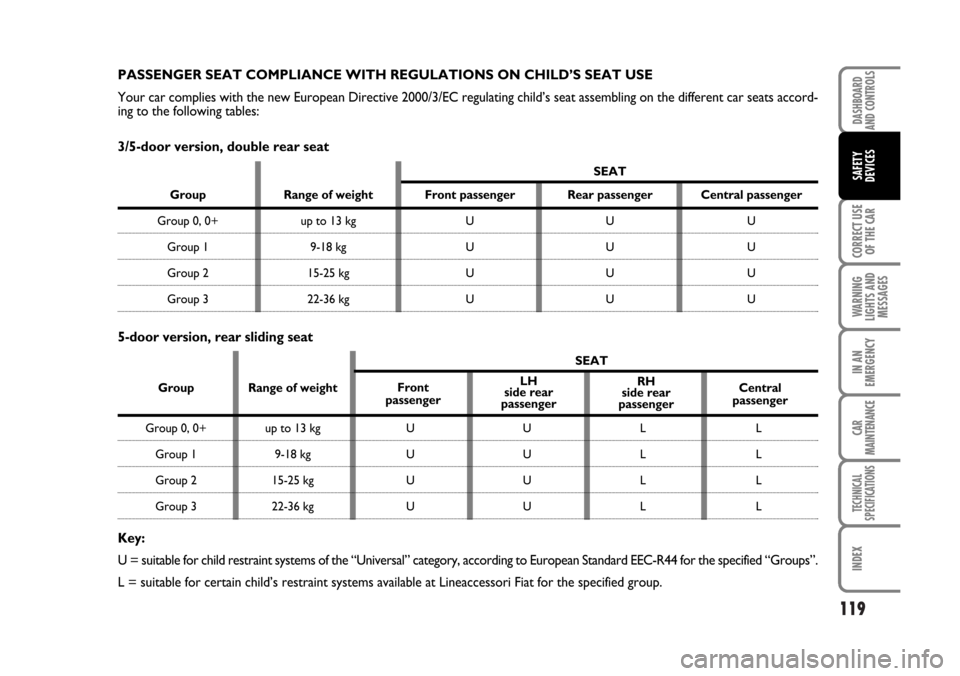
119
CORRECT USE
OF THE CAR
WARNING
LIGHTS AND
MESSAGES
IN AN
EMERGENCY
CAR
MAINTENANCE
TECHNICAL
SPECIFICATIONS
INDEX
DASHBOARD
AND CONTROLS
SAFETY
DEVICES
PASSENGER SEAT COMPLIANCE WITH REGULATIONS ON CHILD’S SEAT USE
Your car complies with the new European Directive 2000/3/EC regulating child’s seat assembling on the different car seats accord-
ing to the following tables:
3/5-door version, double rear seat
5-door version, rear sliding seat
SEAT
Group Range of weight Front passenger Rear passenger Central passenger
Group 0, 0+ up to 13 kg U U U
Group 1 9-18 kg U U U
Group 2 15-25 kg U U U
Group 3 22-36 kg U U U
Front
passengerCentral
passenger
Key:
U = suitable for child restraint systems of the “Universal” category, according to European Standard EEC-R44 for the specified “Groups”.
L = suitable for certain child’s restraint systems available at Lineaccessori Fiat for the specified group.
SEAT
Group Range of weight
Group 0, 0+ up to 13 kg U U L L
Group 1 9-18 kg U U L L
Group 2 15-25 kg U U L L
Group 3 22-36 kg U U L LRH
side rear
passenger LH
side rear
passenger
Page 126 of 274
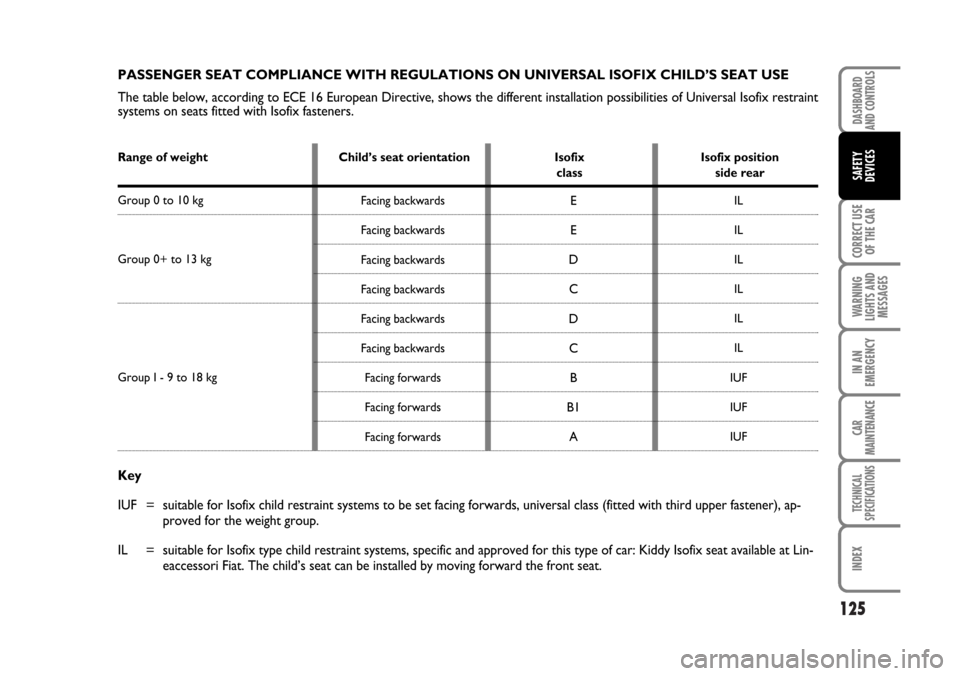
125
CORRECT USE
OF THE CAR
WARNING
LIGHTS AND
MESSAGES
IN AN
EMERGENCY
CAR
MAINTENANCE
TECHNICAL
SPECIFICATIONS
INDEX
DASHBOARD
AND CONTROLS
SAFETY
DEVICES
IL
IL
IL
IL
IL
IL
IUF
IUF
IUF
Key
IUF = suitable for Isofix child restraint systems to be set facing forwards, universal class (fitted with third upper fastener), ap-
proved for the weight group.
IL = suitable for Isofix type child restraint systems, specific and approved for this type of car: Kiddy Isofix seat available at Lin-
eaccessori Fiat. The child’s seat can be installed by moving forward the front seat. PASSENGER SEAT COMPLIANCE WITH REGULATIONS ON UNIVERSAL ISOFIX CHILD’S SEAT USE
The table below, according to ECE 16 European Directive, shows the different installation possibilities of Universal Isofix restraint
systems on seats fitted with Isofix fasteners.
Range of weight Child’s seat orientation Isofix Isofix position
class side rear
Group 0 to 10 kg
Group 0+ to 13 kg
Group I - 9 to 18 kg
Facing backwards
Facing backwards
Facing backwards
Facing backwards
Facing backwards
Facing backwards
Facing forwards
Facing forwards
Facing forwardsE
E
D
C
D
C
B
B1
A
Page 127 of 274
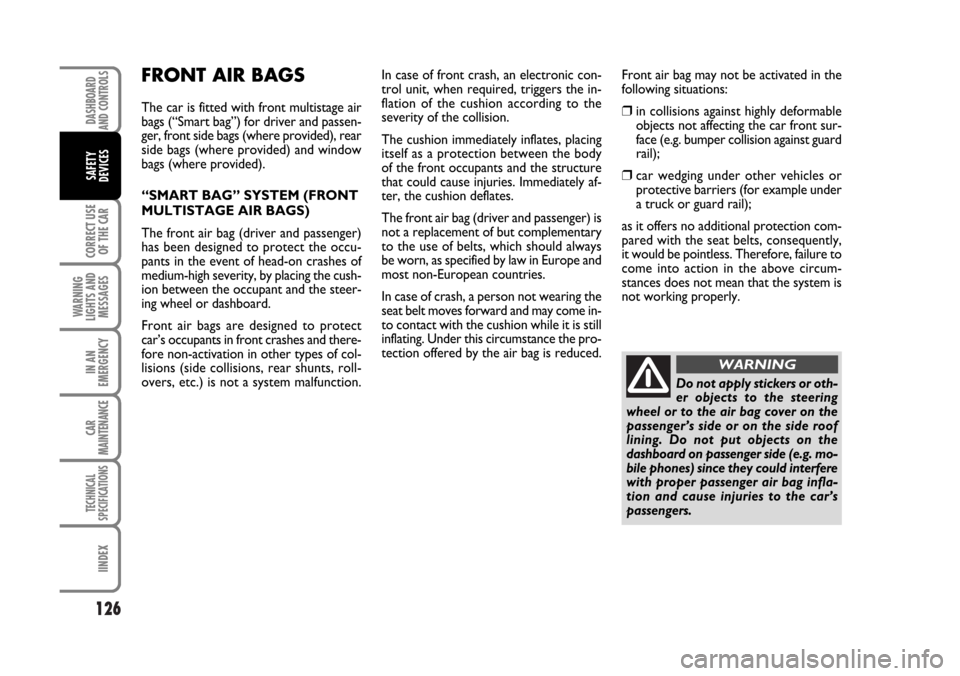
126
CORRECT USE
OF THE CAR
WARNING
LIGHTS AND
MESSAGES
IN AN
EMERGENCY
CAR
MAINTENANCE
TECHNICAL
SPECIFICATIONS
IINDEX
DASHBOARD
AND CONTROLS
SAFETY
DEVICES
FRONT AIR BAGS
The car is fitted with front multistage air
bags (“Smart bag”) for driver and passen-
ger, front side bags (where provided), rear
side bags (where provided) and window
bags (where provided).
“SMART BAG” SYSTEM (FRONT
MULTISTAGE AIR BAGS)
The front air bag (driver and passenger)
has been designed to protect the occu-
pants in the event of head-on crashes of
medium-high severity, by placing the cush-
ion between the occupant and the steer-
ing wheel or dashboard.
Front air bags are designed to protect
car’s occupants in front crashes and there-
fore non-activation in other types of col-
lisions (side collisions, rear shunts, roll-
overs, etc.) is not a system malfunction.In case of front crash, an electronic con-
trol unit, when required, triggers the in-
flation of the cushion according to the
severity of the collision.
The cushion immediately inflates, placing
itself as a protection between the body
of the front occupants and the structure
that could cause injuries. Immediately af-
ter, the cushion deflates.
The front air bag (driver and passenger) is
not a replacement of but complementary
to the use of belts, which should always
be worn, as specified by law in Europe and
most non-European countries.
In case of crash, a person not wearing the
seat belt moves forward and may come in-
to contact with the cushion while it is still
inflating. Under this circumstance the pro-
tection offered by the air bag is reduced.
Do not apply stickers or oth-
er objects to the steering
wheel or to the air bag cover on the
passenger’s side or on the side roof
lining. Do not put objects on the
dashboard on passenger side (e.g. mo-
bile phones) since they could interfere
with proper passenger air bag infla-
tion and cause injuries to the car’s
passengers.
WARNING
Front air bag may not be activated in the
following situations:
❒in collisions against highly deformable
objects not affecting the car front sur-
face (e.g. bumper collision against guard
rail);
❒car wedging under other vehicles or
protective barriers (for example under
a truck or guard rail);
as it offers no additional protection com-
pared with the seat belts, consequently,
it would be pointless. Therefore, failure to
come into action in the above circum-
stances does not mean that the system is
not working properly.
Page 129 of 274

128
CORRECT USE
OF THE CAR
WARNING
LIGHTS AND
MESSAGES
IN AN
EMERGENCY
CAR
MAINTENANCE
TECHNICAL
SPECIFICATIONS
IINDEX
DASHBOARD
AND CONTROLS
SAFETY
DEVICES
MANUAL DEACTIVATION OF
PASSENGER’S FRONT AIR BAG
Should it be absolutely necessary to car-
ry a child on the front seat, the passenger’s
front air bag can be deactivated.
Deactivation/reactivation takes place with
ignition key at STOP, and operating it in
the special key switch on the right-hand
side of the dashboard. You can reach the
switch only if the door is opened.
When the door is open, the key can be in-
serted and removed in both positions.
IMPORTANT Operate the switch only
when the engine is not running and the ig-
nition key is removed.The key-operated switch has two posi-
tions fig. 23:
❒Passenger’s front air bag activated (ON
position
P): warning light Fon in-
strument panel off; it is absolutely pro-
hibited to carry a child on the front
seat.
❒Passenger’s front air bag deactivated
(OFF position F): warning light Fon instrument panel on; it is possible to
carry a child protected by special re-
straint system on the front seat.The warning light
Fon the instrument
panel stays on permanently until the pas-
senger’s air bag is reactivated.
Deactivation of the passenger’s front air
bag does not inhibit operation of the side
bag.
fig. 23F0C0052m
Page 130 of 274

129
CORRECT USE
OF THE CAR
WARNING
LIGHTS AND
MESSAGES
IN AN
EMERGENCY
CAR
MAINTENANCE
TECHNICAL
SPECIFICATIONS
INDEX
DASHBOARD
AND CONTROLS
SAFETY
DEVICES
The front passenger classifi-
cation sensor could not de-
tect or correctly classify the occupant
presence because of the interposition
of cushions or sanitary aids (cushions,
rubber rings, etc.), that therefore
should not be used on the front pas-
senger seat.
WARNING
Never place cutting or sharp
objects on the front passen-
ger seat to prevent damaging the
front passenger classification sensor.
Contact a Fiat Dealership in case of
sensor damages.
WARNING
SERIOUS DANGER: The
front passenger classification
sensor is not studied for the
recognition of the children re-
straints and for the conse-
quent automatic deactivation of the
passenger air bag. If you carry a chil-
dren restraint on the front passenger
seat, it is however necessary to de-
activate the front passenger air bag
through the proper deactivation
switch (see previous paragraph).
WARNING
Do not arrange heavy ob-
jects on the front passenger
seat, because in the event of accident,
the front passenger air bag intervenes
if it is not deactivated through the
proper deactivation switch (see pre-
vious paragraph).
WARNING
FRONT PASSENGER
CLASSIFICATION SENSOR
(OCS = Occupant Classification
System) (where provided)
The front passenger air bag is equipped
with a sensor, located inside the passen-
ger seat between the padding and the ex-
ternal cover of the seat, able to recognize
the presence of the occupant and classify
his/her weight.
This allows ensuring the best protection
under any circumstance, modulating the
inflation pressure of the front passenger
air bag as a function of the occupant
weight.
If an adult sits on the front passenger seat,
the relevant front air bag is ready to in-
tervene in case of need. If the passenger
seat is free, the air bag will not intervene.
IMPORTANT To receive the best system
protection in the event of an accident, you
have to seat in proper position.
Page 131 of 274
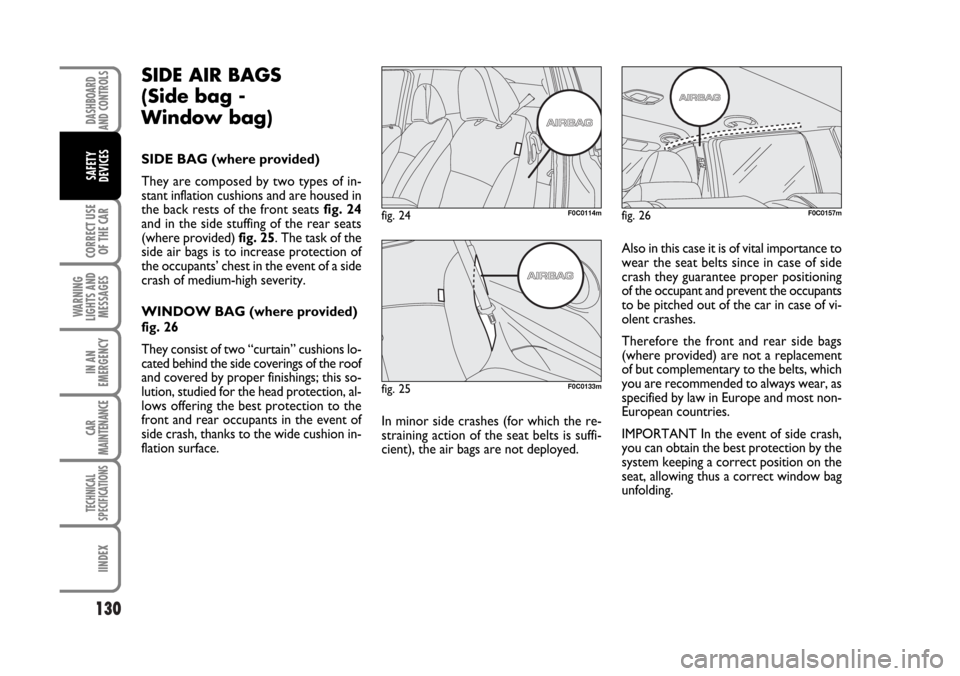
130
CORRECT USE
OF THE CAR
WARNING
LIGHTS AND
MESSAGES
IN AN
EMERGENCY
CAR
MAINTENANCE
TECHNICAL
SPECIFICATIONS
IINDEX
DASHBOARD
AND CONTROLS
SAFETY
DEVICES
SIDE AIR BAGS
(Side bag -
Window bag)
SIDE BAG (where provided)
They are composed by two types of in-
stant inflation cushions and are housed in
the back rests of the front seats fig. 24
and in the side stuffing of the rear seats
(where provided) fig. 25. The task of the
side air bags is to increase protection of
the occupants’ chest in the event of a side
crash of medium-high severity.
WINDOW BAG (where provided)
fig. 26
They consist of two “curtain” cushions lo-
cated behind the side coverings of the roof
and covered by proper finishings; this so-
lution, studied for the head protection, al-
lows offering the best protection to the
front and rear occupants in the event of
side crash, thanks to the wide cushion in-
flation surface.In minor side crashes (for which the re-
straining action of the seat belts is suffi-
cient), the air bags are not deployed. Also in this case it is of vital importance to
wear the seat belts since in case of side
crash they guarantee proper positioning
of the occupant and prevent the occupants
to be pitched out of the car in case of vi-
olent crashes.
Therefore the front and rear side bags
(where provided) are not a replacement
of but complementary to the belts, which
you are recommended to always wear, as
specified by law in Europe and most non-
European countries.
IMPORTANT In the event of side crash,
you can obtain the best protection by the
system keeping a correct position on the
seat, allowing thus a correct window bag
unfolding.
fig. 24F0C0114m
fig. 25F0C0133m
fig. 26F0C0157m
Page 132 of 274
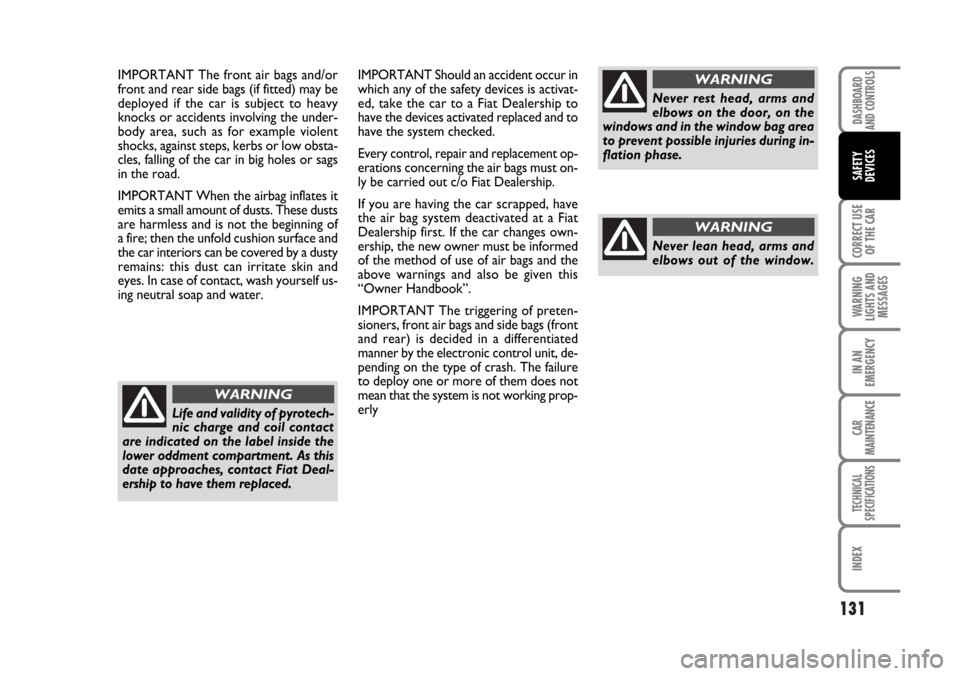
131
CORRECT USE
OF THE CAR
WARNING
LIGHTS AND
MESSAGES
IN AN
EMERGENCY
CAR
MAINTENANCE
TECHNICAL
SPECIFICATIONS
INDEX
DASHBOARD
AND CONTROLS
SAFETY
DEVICES
IMPORTANT The front air bags and/or
front and rear side bags (if fitted) may be
deployed if the car is subject to heavy
knocks or accidents involving the under-
body area, such as for example violent
shocks, against steps, kerbs or low obsta-
cles, falling of the car in big holes or sags
in the road.
IMPORTANT When the airbag inflates it
emits a small amount of dusts. These dusts
are harmless and is not the beginning of
a fire; then the unfold cushion surface and
the car interiors can be covered by a dusty
remains: this dust can irritate skin and
eyes. In case of contact, wash yourself us-
ing neutral soap and water.IMPORTANT Should an accident occur in
which any of the safety devices is activat-
ed, take the car to a Fiat Dealership to
have the devices activated replaced and to
have the system checked.
Every control, repair and replacement op-
erations concerning the air bags must on-
ly be carried out c/o Fiat Dealership.
If you are having the car scrapped, have
the air bag system deactivated at a Fiat
Dealership first. If the car changes own-
ership, the new owner must be informed
of the method of use of air bags and the
above warnings and also be given this
“Owner Handbook”.
IMPORTANT The triggering of preten-
sioners, front air bags and side bags (front
and rear) is decided in a differentiated
manner by the electronic control unit, de-
pending on the type of crash. The failure
to deploy one or more of them does not
mean that the system is not working prop-
erly
Never rest head, arms and
elbows on the door, on the
windows and in the window bag area
to prevent possible injuries during in-
flation phase.
WARNING
Never lean head, arms and
elbows out of the window.
WARNING
Life and validity of pyrotech-
nic charge and coil contact
are indicated on the label inside the
lower oddment compartment. As this
date approaches, contact Fiat Deal-
ership to have them replaced.
WARNING
Page 133 of 274

132
CORRECT USE
OF THE CAR
WARNING
LIGHTS AND
MESSAGES
IN AN
EMERGENCY
CAR
MAINTENANCE
TECHNICAL
SPECIFICATIONS
IINDEX
DASHBOARD
AND CONTROLS
SAFETY
DEVICES
The key-operated switch has two posi-
tions fig. 27:
❒side air bag activated (ONposition
Õ): warning light Àon instrument
panel off; it is absolutely prohibited to
carry a child on the rear seats;
❒side air bag deactivated (OFFposi-
tion
À): warning light Àon instru-
ment panel on; it is possible to trans-
port children protected by proper re-
straints on the front seat.
fig. 27F0C0154m
SERIOUS DANGER: In pres-
ence of small size occupants
(children, etc.) on the rear
seats, it is necessary to deac-
tivate the rear side bags
through the apposite deactivation
switch located in the boot.
WARNINGMANUAL DEACTIVATION
OF REAR SIDE BAGS
(where provided)
Certain versions are fitted with rear side
bags (that can be deactivated) to protect
the chest of rear passengers.
For deactivation: operate the key switch
(with ignition key) located in the boot un-
der the rear shelves as shown in the fig-
ure. The switch can be reached only with
tailgate open.
IMPORTANT Operate the switch only
when the engine is stopped and the igni-
tion key is removed.
Page 134 of 274

133
CORRECT USE
OF THE CAR
WARNING
LIGHTS AND
MESSAGES
IN AN
EMERGENCY
CAR
MAINTENANCE
TECHNICAL
SPECIFICATIONS
INDEX
DASHBOARD
AND CONTROLS
SAFETY
DEVICES
Remember that with the key
engaged and at MAR, even
with the engine not running, the air
bags may be triggered on a stationary
car if it is bumped by another moving
car. Therefore, never seat children on
the front seat even when the car is
stationary. On the other hand, re-
member that with the key at STOP
no safety system (air bags or preten-
sioners) is triggered in the event of an
impact; in this case, failure to come
into action cannot be considered as a
sign that the system is not working
properly.
WARNINGGENERAL WARNINGS
If when turning the ignition
key to MAR, the warning
light ¬does not turn on or if it stays
on when travelling (together with the
message on the display) there could
be a failure in safety systems; in this
event air bags or pretensioners could
not trigger in case of impact or, in a
minor number of cases, they could
trigger accidentally. Contact Fiat
Dealership immediately to have the
system checked.
WARNING
Do not cover the backrest of
front and rear seats with
trims or covers that are not suitable
to be used with side bags.
WARNING
Never travel with objects on
your lap, in front of your
chest or with a pipe, pencil, etc. be-
tween your lips; injury may result in
the event of the air bag being trig-
gered.
WARNING
Always keep your hands on
the steering wheel rim when
driving, so that if the air bag is trig-
gered, it can inflate without meeting
any obstacles which could cause seri-
ous harm to you. Do not drive with
the body bent forwards, keep the seat
back rest in the erect position and
lean your back well against it.
WARNING
If the car has been stolen or
an attempt to steal it has
been made, if it has been subjected to
vandals or floods, have the air bag
system checked by Fiat Dealership.
WARNING
Page 135 of 274

134
CORRECT USE
OF THE CAR
WARNING
LIGHTS AND
MESSAGES
IN AN
EMERGENCY
CAR
MAINTENANCE
TECHNICAL
SPECIFICATIONS
IINDEX
DASHBOARD
AND CONTROLS
SAFETY
DEVICES
When the ignition key is
turned to MAR, the warning
light
F(with passenger’s front air
bag deactivation switch at ON) turns
on and flashes for few seconds to re-
mind that the passenger’s air bag will
be deployed in a crash, after which
it should go off.
WARNING
When the ignition key is
turned to MAR, the warning
light
À(with the rear side bag de-
activation switch at ON) turns on and
flashes for few seconds to remind that
the rear side bags will be deployed in
a crash, after which it should go off.
WARNING
Do not wash the seat back
rest with pressurised water
or steam (by hand or at automatic
seat washing stations).
WARNING
The front air bag is triggered
for shocks greater in magni-
tude than the pretensioners. For im-
pacts between these two thresholds,
it is therefore normal that only the
pretensioners are triggered.
WARNING
Do not hook rigid objects to
the coat hooks and to the
support handles.
WARNING
The air bag does not substi-
tute the seat belts, but only
increases their effectiveness. More-
over, since the front air bags do not
come into operation in the event of
front impact at low speed, side colli-
sions, bumps from behind or over-
turning, in these circumstances the
occupants would only be protected
by the seat belts which must therefore
always be fastened.
WARNING